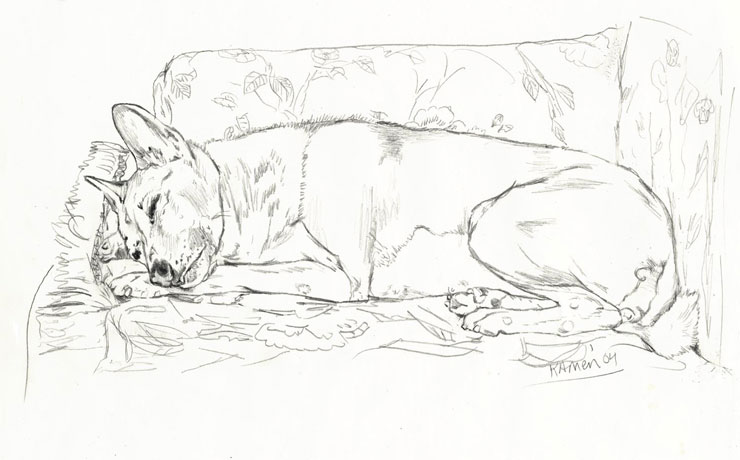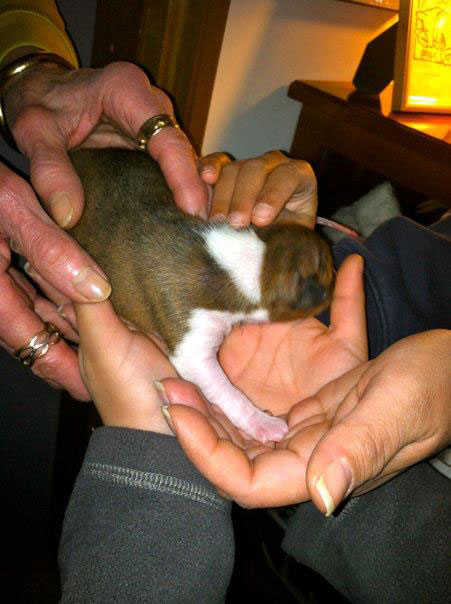Page 9 <previous page > <next page>
SOME HEALTH & SCIENCE NEWS
1. Canine Circovirus - UConn Rearchers ID Dog Disease New To Connecticut.
2. IT’S NOT “ALL IN HOW YOU RAISE THEM”: THE ROLE OF GENETICS IN BEHAVIOR
3. A gel made in Washington is killing cancer in pets.
(Patty Ewing says symptom to look out for is bloody diarrhea.)
UConn Rearchers ID Dog Disease New To Connecticut
A canine disease has been identified in Connecticut for the first time.
by Chris Dehnel, Patch Staff
Oct 16, 2019 10:39 am ET
UConn Rearchers ID Dog Disease New To Connecticut
(UConn Extension)
STORRS, CT — A disease affecting dogs — Canine Circovirus — has been pinpointed for the first time in the state by University of Connecticut researchers.
Investigators at the Connecticut Veterinary Medical Diagnostic Laboratory, or CVMDL, at UConn recently reported a new canine disease, identified for the first time in New England. The reserchers represent the same group and laboratory that recently reported eastern equine encephalomyelitis in horses and birds and earlier recognized epizootic hemorrhagic disease in deer (September 2017) and West Nile encephalitis in crows (2001).
The published case report in the September 2019 edition of the Journal of Veterinary Diagnostic Investigation documents the death of a 5-month-old dog that "originated" in Mississippi, was shelter-housed in Texas for a time, and then was "delivered" for adoption in Connecticut.
According to the researchers, the disease was characterized by severe bloody gastroenteritis and rapid progression to death. An autopsy was followed by electron microscopy and exam using molecular techniques that "demonstrated a circovirus as the cause of disease and death."
"First recognized in California in 2013, the appearance of canine circovirus disease in New England, in dogs shuttled among shelters, raises concerns for dog owners and veterinarians," researchers said.
They concluded, "At this time, it is hard to know if this disease will spread, like parvovirus disease in the 1980s, or remain sporadic."
A UConn spokeswoman added, "We'll have to see if it spreads at all, that will determine how serious it becomes."
The CVMDL is part of the Department of Pathobiology in UConn's College of Agriculture, Health and Natural Resources.
IT’S NOT “ALL IN HOW YOU RAISE THEM”: THE ROLE OF GENETICS IN BEHAVIOR

December 19, 2016 Jsummerfield8 - Dr. Jen's Dog Blog
If you’re a dog owner, I’m sure you’ve heard this refrain.
Conventional wisdom says that young puppies come to us as blank slates. Full of promise and limitless potential, ready to be molded into your ideal companion as long as you do your part – provide lots of love, the right amount of discipline, and appropriate training along the way. If you’re a caring, responsible pet owner, there’s no reason that your puppy should not grow up to be a model canine citizen.
“Bad” dogs are the fault of bad owners, right? After all, it’s all in how you raise them.
********
As always, in the world of behavior – it’s not quite that simple.
There are few myths in the field of dog training that get under my skin quite as much as this one. Perhaps it’s because I’ve seen so many kind, committed owners with deeply troubled dogs break down in tears during a behavior consultation, certain that they have done something to cause their dog’s crippling anxiety or aggression issues. After all, they’ve had him since he was a puppy – so clearly, something must have been lacking in his upbringing.
Or perhaps it’s the countless number of fundamentally mismatched dog/owner pairings that every veterinarian and trainer sees on a regular basis. The gentle elderly couple, with the adolescent field-bred Lab. The busy young professionals with three children under the age of five, with the spooky English Mastiff who doesn’t like kids. Or even the lovely middle-aged woman who wants to do therapy work in a local nursing home, with her aloof and introverted Chow.
What all of these situations have in common, at their core, is a lack of understanding combined with an unfortunate and excessive sense of optimism – an unshakeable faith in the notion that any dog can be molded into the perfect pet for the owner’s particular lifestyle, as long as they’re “raised right.” That every eight-week-old puppy is a formless mass of behavioral clay, ready to be imprinted with whatever characteristics and personality traits are most convenient for their living situation and the wishes of their new family.
Unfortunately for all involved in the examples above, this is utterly and emphatically not true.
But wait, you might say! What about socialization and training? Can’t we influence our puppies’ adult characteristics through exposure to the things we want them to be comfortable with? Can’t we teach them early on how we want them to behave, thus preventing any problems later on?
In other words, a perfectly socialized and well-trained puppy should be a foolproof bet to turn out the way we want – right?
Well… the answer, as they say, is complicated.
Don’t get me wrong – socialization and early learning are very powerful things. (See my previous posts on these topics here and here for a more complete discussion of how they influence puppy development, if you’re interested.) There is a lot we can do to set our puppies up for success, and also to address possible problems or behavioral red flags early on. This is the “nurture” side of the nature-and-nurture paradigm, and it’s incredibly important – but it’s only half of the equation.
So what does nature have to say?
We all know intuitively that behavioral characteristics can be inherited. After all, this basic notion is the reason for thousands of years of selective breeding in the dog world – it’s why we’ve been able to develop specific lines of dogs who are consistently driven to retrieve things, herd sheep, guard our homes, or track rabbits without any formal training at all. Why, then, does it surprise us that other types of behavioral tendencies can also be passed from parents to offspring?
The truth is, your dog’s genetic background plays a tremendous (and often under-valued) role not only in what inborn skills he might have, but in who he is – whether he is friendly or reserved with strangers, tolerant of other pets or not, a high-drive athlete or a snuggly couch potato, easily startled by loud noises or relatively “bombproof.”
Since the 1940s, studies in canine behavioral genetics have consistently shown that traits such as fearfulness, impulsivity, problem-solving ability, working drive, and even tendencies toward aggression are strongly influenced by breeding. Socialization and early learning can certainly help to sway things in one direction or another, but these forces are operating on a pre-existing genetic blueprint.
Is behavior moldable? Of course it is – to a point. You can only modify what you already have, not create the dog of your choosing from scratch. So if you have specific goals for your pup or need a dog with a certain personality type, it pays to make sure that you’re getting a temperament you can live with!
Please note that none of this should be taken as a defense of breed-specific stereotyping or discrimination, on the theory that certain breeds are bound to be aggressive or otherwise “bad.” There is a tremendous amount of genetic variability within every breed – so much so that it’s not possible to make any reliable predictions about behavior based solely on breed identification. It’s much more valuable to look specifically at the parents and littermates of a particular puppy, or at a certain line of dogs within a breed.
So, what can we do with this knowledge?
If you have specific personality traits that you need in a dog, don’t choose a puppy based on looks or a cheap purchase price and assume that you can “make it work” – this rarely goes well, in my experience.
Instead, I would strongly encourage you to look into getting a puppy from an excellent breeder, with a good track record of producing dogs with the traits that you want – this is your very best chance of ending up with a dog that will be a good fit for you and your family. Many owners need a dog that is reliably gentle and tolerant with kids, or with low prey drive because of smaller pets in the home, or easygoing and low-energy because they are elderly or disabled. Getting an adult dog from a trusted source who knows the dog well (such as a breeder, or a good rescue group) can also be a great option.
This kind of predictability may not be important for all owners – which is fine! Many of my clients don’t have any specific plans or goals for their dog, and their lifestyle is flexible enough that a wide range of personality types would fit into their household with no problems. If this describes you, then you could absolutely open your home to a puppy or older dog with an unknown background and see where life takes the two of you. There are many such dogs who desperately need homes, and the relationship that you have with a dog like this can be extremely special.
By the same token – if you are thinking about breeding your dog, or if you already have an active breeding program, please carefully consider temperament in your breeding decisions! Most good breeders know this already and are very selective about which dogs they choose to breed, but this idea can be surprising to many owners who are new to the process and aren’t aware that personality traits can be inherited. Excessively fearful or aggressive dogs should not be bred – period. These issues should be taken as seriously as hereditary physical problems like hip dysplasia or degenerative myelopathy, as they are every bit as devastating for both the puppy and his/her new family.
And finally, if you have a pup from an uncertain background (or a known, not-so-great background) who is struggling with a behavior problem despite your best efforts, don’t beat yourself up! For many of my clients, it comes as a relief to know that they have done nothing wrong – the misplaced guilt that comes with having a much-loved dog who is also severely aggressive or fearful of everything can be crushing.
It helps to understand that you can only play the hand you’re dealt; all dogs come with their own personalities and behavioral tendencies, for better or worse. We can do a lot to help these dogs live safer, happier lives with training and careful management – we can build their confidence, teach them better coping skills to handle stress, and strengthen their bond with their owners – but we can’t change who they are. And usually, that’s okay.
So if you have a dog like this, to paraphrase the famous Serenity Prayer – I would encourage you to work on the things you can change, and accept the things you can’t.
The trick is learning to know the difference.
A gel made in Washington is already killing cancer in pets.
Humans could be next
The novel radiation treatment was developed for animals in the Tri-Cities. Scientists hope to begin human clinical trials in the near future.
by Emily McCarty/Crosscut / September 6, 2019
In August of last year at the University of Missouri’s College of Veterinary Medicine, a shaggy sheltie dog lay unconscious on a CT scan bed, his muzzle loosely taped shut to keep his breathing tube in. His hind leg had a shaved patch with a dotted grid mapping out a tumor.
Three people watched behind glass in another room as the bed moved the dog into the ring-shaped machine. They were testing IsoPet, a brand new type of radiation therapy that involves injecting a radioactive gel instead of the traditional method of beaming radioactive rays into the tumor from outside the body.
Less than 10 minutes later, Dr. Darrell Fisher, a medical physicist based in Richland, Benton County, who helped invent IsoPet, looked at the scan’s results on the computer screen. What looked like a white blob on the scan was exactly the result they’d hoped for: The radiation gel they’d injected into the dog spread evenly throughout the entire tumor without spreading to surrounding healthy tissue.
“This was it, this was the solid evidence that we were able to achieve uniform distribution,” Fisher says. “I’ll never forget that.”
The test results meant more than a longer life for the dog. It represented a potential breakthrough in treating cancer with radiation for Vivos, the Richland-based pharmaceutical company that developed and produced the treatment in conjunction with Pacific Northwest National Laboratory.
Pets are just the first step. Eventually, the team wants it to be available to treat cancer in humans. If approved by the Food and Drug Administration, the product will be called RadioGel, as the FDA requires a different name for human use.
Vivos’ next step is to collect enough safety and efficacy data to get premarket approval from the FDA. Vivos CEO Dr. Mike Korenko says that process will take about a year and cost about $1.5 million; once completed, Vivos can move on to clinical trials in humans.
Right now, the treatment is available to the public only at Vista Veterinary Hospital in Kennewick. Vivos hopes to make it available to veterinarians across the country within six months, says Korenko.
Korenko is also reaching out to human hospitals. He spoke with a representative from the Mayo Clinic at a medical conference and has reached out to St. Jude’s Children’s Hospital. It may be especially helpful for kids, Korenko says, since chemotherapy is especially damaging to growing tissue. He says the doctors he spoke to were eager to learn more about potential use in humans.
A anesthetized cat receives a treatment from a doctor
Drake, the first animal to receive the IsoPet treatment outside of clinical trials, is injected by Dr. Michelle Meyer of Vista Veterinary Hospital in Kennewick. (Provided by Mike Korenko)
“[On] the human side, you talk to a doctor, and they said, ‘My God, [this] is the first [new] tool in our toolbox we've had in 20 to 25 years,’” Korenko says. “So it's pretty exciting, [but] it's going to take us four or five years to get into human therapy.”
Treatment for pets currently costs about $9,500. Korenko wants to lower the price as soon as possible, saying he doesn’t want to treat only “rich people’s cats and dogs.” The first animal to receive IsoPet treatment outside of clinical trials at veterinary schools was Drake, a black and gray cat with a facial tumor. He was flown in from Sitka, Alaska, by his owner, veterinarian Dr. Burgess Bauder. Drake was treated at Vista Veterinary Hospital by Dr. Michelle Meyer, the first vet to be certified to administer the gel outside of trials.
On July 10, Drake was given a physical examination and anesthetized, and the area around his facial tumor was shaved and prepped. A grid was drawn with marker to make sure injections were 5 millimeters apart.
To prepare IsoPet, two vials, both on ice, were combined: one with radioactive particles in a liquid and the other with a liquid that gels when warmed by body temperature. Meyer gave Drake multiple injections over a period of 20 minutes. A technician trained in the handling and transport of the radiation stood by alongside a radiation safety officer.
“It was pretty amazing, just to be a part of it and to see the pictures afterwards of Drake and see how well it’s working,” Meyer says.
Almost two months after the injections, Bauder says the tumor has decreased by about 90%.
There are limitations to IsoPet/RadioGel’s practical uses. Cancers with solid, isolated tumors represent the best treatment cases; it’s not appropriate for widely disseminated cancers, like leukemia or metastatic breast cancer.
“If the cancer is spread through lungs and liver and spinal cord and brain, this is not for that,” Fisher says. “But if one needs to treat single, solid tumors, this is just the ticket. It’s the cat’s meow.”
